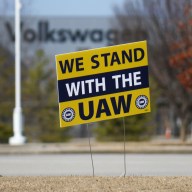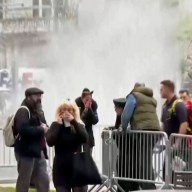 Snow or not, MetLife Stadium will be cold on Super Bowl Sunday.
Snow or not, MetLife Stadium will be cold on Super Bowl Sunday.
Credit: Getty Images
A cold-weather Super Bowl will mean erratic throws from quarterbacks, more slipping and sliding and will even impact how players hear things on the field.
By the time the Super Bowl kicks off Sunday night at MetLife Stadium, the weather pattern for the evening will be dissected every way imaginable. But while it will be cold and uncomfortable in what will likely be the coldest ever Super Bowl, the impact is much more than long johns for fans and gloves for the quarterbacks. The weather and the cold will have a direct impact on the game, even if it isn’t snowing.
Dr. Eric Goff, professor of physics at Lynchburg College and the author of “Gold Medal Physics: The Science of Sports” said cold weather and not just possible snow could impact how the game is played. He said with a Miami Super Bowl likely registering a temperature of 75 degrees and a north Jersey game in the mid-30s, there will be an impact in air drag which will affect the game.
“Because air density is inversely proportional to temperature – you must measure temperature in kelvin for this calculation – quarterbacks and kickers will face about 8 percent more air drag in East Rutherford, [N.J.] compared to Miami. Peyton Manning plays in Denver, which had lower air density than at sea level where the Super Bowl will be played,” Goff said. “On paper, Manning might be affected by more air drag than a quarterback who plays at sea level, but, in reality, Manning has been in the league long enough and played at sea level plenty of times that he should be able to adapt. Still, he’ll have to adapt.”
In addition, the lower humidity likely to be in play on Sunday will lead to an increase in air drag, but Goff said “the effect is not nearly as large as the effect from temperature change.”
There will also be a drop in elasticity due to the cold temperatures, with the physics of sports coming into play. The turf will be harder and not as spongy and the ball when it bounces won’t bounce as high. Something like this could impact a directional punt where a team tries to pin an opponent deep in their own end.
This cold, harder-than-usual turf could also impact players and their balance, creating more slips than usual.
“In general, the friction coefficient associated with shoes and turf goes down as the temperature goes down. That means there is greater chance of sliding in the cold than on a warm field in Miami,” Goff said. “Some studies show as much as 10 to 12 percent reduction in friction coefficient, which is a reasonable reduction when comparing Miami to East Rutherford. I can’t be more specific without knowing exactly what shoe type players will wear. Shoe science, as you might imagine, advances fairly rapidly. Trainers will have specific shoes in mind, along with specific stud type and length.”
But it is trickier than just air drag or a hard field creating tricky steps for players. The cold could have an impact on how things are communicated on the field and could keep the crowd out of it.
The already chaotic scene of a football field with players moving quickly before the snap and shouting amidst the background of crowd noise could be harder to do. This is especially noticeable when stacked against a warmer locale, such as a Super Bowl in Arizona or Florida.
“There will be an almost 4 percent drop in sound speed in the cold. That effect is hard to notice, but easier to notice will be the cold fans,” Goff said. “They won’t move as fast as in warm weather. If they do the wave, it’ll likely move a little slower than it would in Miami.”
Follow Jets beat writer Kristian Dyer on Twitter @KristianRDyer.
















